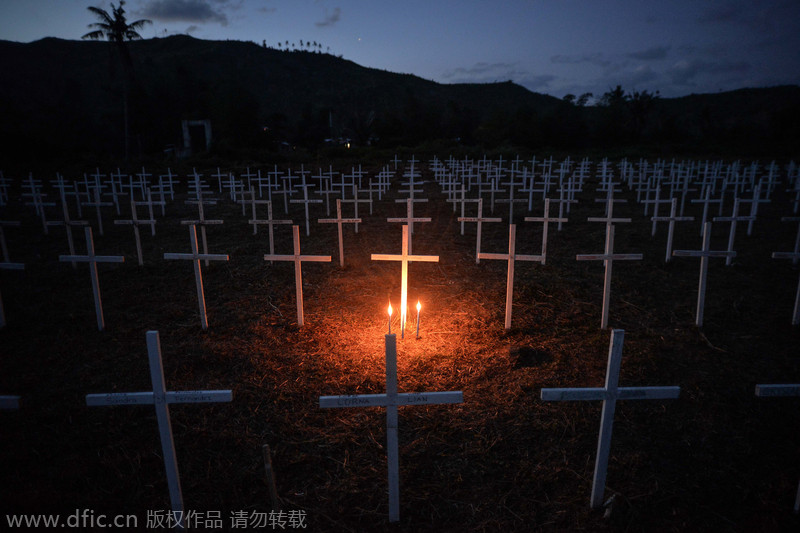 |
|
Candles are lighted next to a wooden cross at a mass gravesite for Typhoon Haiyan victims in Tacloban, Leyte province, Philippines, November 6, 2014. [Photo/IC] |
MANILA - A year after super-typhoon Yolanda, internationally known as Haiyan, hit the central Philippines on Nov 8, 2013, life in the worst-hit areas, including Tacloban City, is almost back to normal.
Signs of normalcy can be seen in the hassle and bustle of the market place, the ubiquitous tricyles (three-wheeled passenger motorbikes) causing traffic jams in some city streets and people lining up in fast-food outlets and flocking to reopened malls.
In the rural areas of the province of Leyte of which Tacloban City is the capital, farmers have gone back to tilling their farms and fishermen have resumed their daily struggle to eke out a living.
While normalcy is now noticeable in Tacloban City, there are still signs of extreme poverty in some areas with many still don't have enough food to eat not to mention the lack of shelter and sanitation facilities. There is also the lack of employment opportunities for the displaced families.
In a report, Save the Children Philippine country director Ned Olney was quoted as saying that poverty is still high in the typhoon-hit areas, whose residents are already among the poorest in the Philippines.
"There's no question in my mind the poor are poorer than they were before the typhoon... many thousands of families in the typhoon-affected areas are still living hand to mouth," Olney said.
With strength of 270 kilometers per hour, Yolanda was the strongest typhoon to hit landfall anywhere in the world. It was followed by tsunami-like waves that literally wiped out Tacloban City.
Official government data show that the number of dead from the disaster topped 6,300 while 28,689 were injured and 1,061 still missing. But local officials said that the death toll could be as high as 10,000 because some of the dead could have been sucked by the receding flood waters and their bodies were never recovered.
Total number of people affected was placed at 13 million or 7.8 percent of the country's population.
The World Health Organization placed the Yolanda disaster at Category 3, which was at par with the 2004 Indian Ocean tsunami and the Haiti earthquake in 2010.
After the disaster, scores of foreign countries came to help in the rescue and recovery efforts. These included China which sent its state-of-the-art Peace Ark Hospital Ship to provide treatment to the injured survivors. China also dispatched medical teams and sent relief assistance.
After some initial bickering due to politics, the government of President Benigno Aquino III has launched a massive reconstruction program in the disaster-hit areas. The government, along with the foreign donors, has constructed hundreds of temporary bunkhouses and has provided financial and food assistance to thousands of survivors.
But it was only last month, almost a year after the catastrophe, when President Aquino approved the 167.9 billion pesos (3.82 billion U.S. dollars) Comprehensive Rehabilitation and Recovery Plan (CRRP) that is aimed at solidifying the government's commitment to rebuild areas devastated by Yolanda.
Presidential Communications Secretary Herminio Coloma Jr. said that the CRRP, which was recommended by former senator Panfilo Lacson, presidential assistant for Rehabilitation and Recovery, outlines the government's commitment to implement over 25,000 specific rehabilitation and recovery plans and programs and activities.
Under the plan, the government will undertake massive efforts to rehabilitate the 171 affected cities and municipalities in 14 provinces and six regions known as the "Yolanda corridor," based on the "build-back-better" principle.
The recovery plan focuses on long-term and sustainable efforts to reduce vulnerabilities and strengthen the capacities of communities to cope with future hazard events. It will rebuild damaged infrastructure, set up new settlements and basic community facilities, and provide livelihood among the affected residents.
Lacson earlier said the government was aiming to complete about 85 to 90 percent of the rehabilitation of areas devastated by the typhoon before the end of President Aquino's term in 2016.
He said that a total of 18,400 rehabilitation projects are being undertaken in the devastated areas under the CRPP.